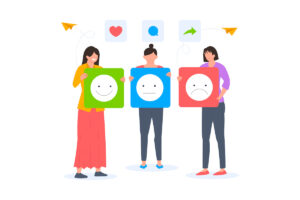Prepared for the artificial robot uprising? Would you back yourself in a fight against your now sentient toaster?
Pop culture and tech columnists would have you believe that we’re a hop, skip and a jump away from an ethical hellhole, sponsored by our new robot overlords. Even a world-renowned scientist like Stephen Hawking is worried that AI “could spell the end of the human race”. So, you should be too, right?
Just take a look at the latest Boston Dynamics video, with their Spotmini robots, that looks eerily like the murderous robot dogs from Black Mirror, and can open doors and work in conjunction with robot ‘buddies’.
It’s enough to trigger anxiety every time you look at your hoover.
But, perhaps we should scale back a bit. Instead of prematurely imagining our dystopian future, we need to think about some of the practical, real-time implications of AI and its impact on the way we do things. Yes, there will be existential risks with artificial intelligence, but we need to think about the standard of AI we’re creating and its application.
Let’s take a look at some of AI’s current drawbacks and lower your robot-panic-induced heart rate.
Leave the Emotion to the Humans
There seem to be some insanely high expectations for AI and as the title of this piece suggests – there are some areas of expertise that just don’t require ‘intelligence’.
Take the recent CES conference for example, with the brightest and best that AI has to offer on show in Las Vegas. The Daily Beast’s tech reporter, Taylor Lorenz, detailed some AI bum notes in her illuminating and fun article. The FoldiMate jumped out as a dubious waste of AI time, with an $850 machine that is supposed to fold your clothes – that’s after you “individually button up each shirt then manually clip it onto the machine” – hailed by the creators as a ‘smart home’ item, the opposite seems more appropriate. Artificial intelligence or just artificial stupidity?
This leads me to the all-important social currency in marketing – emotion. I’m a champion of humanizing marketing techniques and I encourage brands to make real, meaningful connections with their customers. When companies connect, it makes business sense.
And I do think that AI can help out with engagement, but that’s with hand-holding. AI shouldn’t be doing the emotional work, it should be enabling humans to do so. That’s why I see AI trying to become a substitute for natural, human-driven emotion in marketing similar to the FoldiMate – it’s creating more complexity around a simple task and charging hundreds of dollars for the privilege.
Define AI’s role in your company. Let it find cost-saving initiatives and ways to improve productivity, and let it pave the way for your people to focus on building better customer experiences, but don’t leave the emotion to AI.
AI shouldn’t be a substitute for the most engaging, core connection that your brand builds with customers. AI works best when it functions in combination with humans and helps a team of marketers to engage with customers more meaningfully through data analysis.
For example, if you’re using chatbots at certain points in your customer journey – set out what exactly your chatbot can and cannot answer. Manage expectations and only use a chatbot for very specific functions and questions, otherwise, you’ll frustrate customers. Be transparent with your customers and tell them when they’re chatting to a bot and why they are.
Marketing Limitations
Where, when and how we choose to apply artificial intelligence needs to be thought about carefully and we should use the traits that mark us out as a human to decide. And this means being confident about areas where artificial intelligence can’t and shouldn’t replicate human creativity too.
From a marketing perspective, there isn’t a one-size-fits-all artificial intelligence tool yet that covers your whole marketing strategy and as marketing has so many disconnected, moving parts; this doesn’t come as much of a surprise.
A vast amount of rich datasets can make or break a quality artificial intelligence system because it’s limited by data availability. That’s why it’s difficult for AI to function on small amounts of data. But it can also be difficult if your data is captured in different places. When marketing, you’re probably using a wide range of different tools and platforms, so there’s potential for data disparity and loss.
This means that you can be delayed in gathering and organizing your data which means you can fall behind when making real-time decisions. AI integration and interaction with datasets is still imperfect.
AI has become shorthand for complex algorithms that are tough to fully understand. And the systems built have their own intrinsic limitations and biases – the inputs used in an AI model, the actions that are possible, the data and algorithms used all create constraints.
Outcomes like visual recognition, sentence parsing, and sentiment analysis are all still really tough for artificial intelligence to handle, but when left to humans, we can fall back on creative intuition to tackle these simple tasks.
Brands should focus on value-adding AI decisions, instead of reaching for the stars and falling flat. We still desperately need human autonomy in our marketing structures – Peter Norvig, director of research at Google talks about how using AI will “often mean that it is impossible to work out exactly why an AI system does what it does”. Decisions need to be able to be scrutinized so that we can learn from them – it’s easier to explain decisions when they’re based in predominantly human decision-making. Norvig adds that “the challenge then is to come up with new ways of monitoring or auditing the very many areas in which AI now plays such a big role”.
Using AI for certain tasks can just overcomplicate parts of your marketing strategy and end up creating more confusion and over-lapping suggestions. Our emotions, feelings and subjective thinking enable us to make certain decisions and there are areas where AI can’t replicate this type of precision.
Final Thoughts
Artificial intelligence is going to take us on a wild and crazy journey – it’s inevitable. But we have to be asking far-reaching, robust questions about how far we let it go.
Commonly accepted approaches and industry standards need to be created and shared amongst marketers, developers, designers etc. Before we start displacing human workers and their creativity, subjectivity, and imagination with AI systems, there need to be more and more conversations about regulation, protection, and AI ethics.
AI can help with human decision-making, instead of substituting for it and we need to preserve the unique human qualities we possess in our marketing structures so that we can create better emotive customer-focused experiences.






